
Wartime Heritage
ASSOCIATION


copyright © Wartime Heritage Association
Website hosting courtesy of Register.com - a web.com company
Remembering the War Years
Fusilier Arthur Joseph LeBlanc
Name:
Service No:
Rank:
Service:
Date of Birth:
Place of Birth:
Date of Enlistment:
Place of Enlistment:
Address at Enlistment:
Age at Enlistment:
Height:
Complexion:
Eyes:
Hair:
Trade:
Religion:
Marital Status:
Next of Kin:
Date of Discharge:
Date of Death:
Age at Death;
Cemetery:
Arthur Joseph LeBlanc
F/35491
Fusilier/Private
Princess Louise Fusiliers (Motor) Canadian Army
Princess Louise Fusiliers (Motor) 5th Canadian
Armoured Division
September 26, 1922
Abrams River, Yarmouth Co., NS
March 28, 1941
Halifax, NS
Abrams River, Yarmouth Co., NS
20
5 feet 9 inches
light
brown
brown
Labourer
Roman Catholic
Single (at enlistment)
Eva LeBlanc (Mother) Abram’s River, Yarmouth Co., NS (at enlistment)
Yvonne Marie (DeLetter) LeBlanc (Wife) Chausse de Coutral 7, Machelen, Belgium (January 3, 1946)
June 21, 1946 (Halifax, NS on demobilization)
February 16, 2002
79
St. Anne's Cemetery, Ste. Anne du Ruisseau, Yarmouth Co., NS
Arthur Joseph LeBlanc was the son of Melbourne Joseph LeBlanc (1886–1971) and Eva Comeau
(1889–1976) of Abrams River. He had four brothers and three sisters. He completed grade nine and was
fifteen years of age when he left school. He enjoyed school; however, he left as he had to work.
Between 1938 and 1941 he worked on his father’s farm. In 1940, he was employed as a carpenter’s
helper during construction of the Yarmouth Airport for three months, at a salary of $ 20.00 a week.
As a young man, Arthur enjoyed reading and the study of electricity. He was a boxer, a swimmer,
and a softball catcher.
Arthur LeBlanc joined the Princess Louise Fusiliers in Halifax on March 28, 1941. When asked the
reason for enlisting, his response was that his brother was in the Army and he thought he should join and
should like to be in the Army as well. At enlistment, Arthur indicated his interest in motor mechanics.
While stationed at the Halifax Armouries, the recruits received training in the use of the
Regiment's assigned weaponry, Vicars machine guns and 4.2 inch (heavy) mortars. While in Halifax, the
recruits were given the choice of re-assignment to other Regiments. Those from Halifax remained with
the Princess Louise Fusiliers while others transferred to other Nova Scotia Regiments. Arthur remained
with the Fusiliers.
With the rank of Private between March 28, 1941 and February 8, 1942 his principal duty was as a
guard in outpost defences with the Infantry (Machine Gun) PLF. Between February 8, 1942 and
November 5, 1942 he served with the Infantry (Motor Transport) PLF training as a Driver Operator.
The troops also received training at Debert, NS. While there, Arthur was granted leave between
September 29, 1941 and October 12, 1941 and again granted special leave between September 5, 1942
and September 9, 1942. Between February 8, 1942 and November 5, 1942 he trained as Infantry
(Motor) Driver Operator and qualified as a Driver Operator on September 21, 1942
The Princess Louise Fusiliers (Machine Gun) Active Force troops embarked at Halifax on HMS Queen
Elizabeth on October 26, 1942 arriving at Gourock, Scotland in the United Kingdom on November 4,
1942.
The Regiment was mobilized as the 1st Battalion, The Princess Louise Fusiliers (Machine Gun),
Canadian Army Special Force (CASF) for active service on January 1, 1941; re-designated The Princess
Louise Fusiliers (Motor), CASF on January 26, 1942; 1st Battalion, The Princess Louise Fusiliers, Canadian
Infantry Corps (CIC), CASF on January 31, 1943; 11th Infantry Brigade Support Group (The Princess
Louise Fusiliers), CIC, CASF on August 12, 1943; and 11th Independent Machine Gun Company (The
Princess Louise Fusiliers), CASF on July 1, 1944. [1]
With arrival in England in November of 1942, the Princess Louise Fusiliers found themselves “in
the war” as Britain had to endure the bombing of their towns and cities as well as attacks from flying
bombs and rockets. Rationing of food had begun in January 1940 and clothes in June 1941. By 1943,
virtually every household item was either in short supply and had to be queued for, or was unobtainable.
On January 29, 1943 Arthur was admitted to No. 6 Casualty Clearing Station at Cranleigh, Surrey
and to No 5 General Hospital. He was discharged on February 16, 1943 to No 4 Canadian Infantry Re-
enforcement Unit.
Having spent two years of the war uneventfully in the United Kingdom, the Princess Louise
Fusiliers transferred to the Mediterranean theatre to join the 1st Canadian Infantry Division as part of I
Canadian Corps, under command of the British Eighth Army. They left England on October 23, 1943. At
this time Arthur was assigned to the 11th Infantry Brigade Support Group (The Princess Louise Fusiliers)
and was qualified as a Driver Operator - Group “C”.
While in England the Princess Louise Fusiliers were stationed for a time in the town of Kingswood
in Surrey, England. On November 14, 2004 the town of Kingswood dedicated a new tablet added to the
Kingswood War Memorial in memory of the men of the Canadian Armed Forces who were stationed
locally. [2] It states:
“In memory of the Men of the Princess Louise
Fusiliers & 48th Highlanders of Canada who
were stationed locally and gave their lives for
our Freedom. 1939-1945”
Arthur sailed on the SS. Monterey as part of Operation Timberwolf [3] with troops embarking at
Liverpool, Glasgow, and Gourock from 23 to 26 October and meeting in the Clyde.
Early on the morning of October 27, the ships were out into the mouth of the Mersey. By early
morning the convoy was away from Liverpool, steaming south from the mouth of the Clyde. 24 ships had
formed up in three columns. Of the 24 ships, nine were troop transports, the John Ericsson, Monterey,
Edmund B. Alexander, Marnix Van Ste. Aldegonde, Santa Elena, Thurston, Argentina, James T. Parker,
and the Sloterdijk. The others were fast freighters with a complement of destroyer escorts to shepherd
Convoy KMF-25 as it was code-named, to its destination. Soldiers were not aware of where that might
be.
After steaming through the choppy seas, first in a westerly direction through Liverpool Bay, the
convoy cleared Holyhead Island at the western reaches of North Wales where it turned due south. With
the convoy on a southerly route, the consensus of opinion as to the destination, was that they were on
our way to the Mediterranean, most likely Italy. [4]
The convoy was transited the Gibraltar straits on November 4 after a wide course through the
North Atlantic. On November 6, German torpedo bombers attacked the convoy north of Philippeville,
hitting three ships. The SS Santa Elena, with 1,800 Canadian personnel, was forced to abandon ship, and
survivors were taken aboard SS Monterey, already carrying most of the 11th Infantry Brigade, and US
destroyers. There was no loss of life among the Canadians; however, personal equipment and kits was
lost.
The 18,017-ton Monterey, a War Shipping Administration-allocated Matson ocean liner serving as
a troopship and carrying 3,966 soldiers, was in the convoy under the command of Captain Elis R.
Johanson and was defensively armed with 20-mm anti-aircraft cannon. One torpedo-bomber shaped to
attack the ship but was shot down by the ship’s gunners before a torpedo could be dropped. The
aeroplane began to lose altitude and as it passed over Monterey, striking and ripping away some radio
equipment. [5]
The SS Monterey was unable to dock at Philippeville due to rough seas, and went to Naples instead.
The convoy split up and continued to August, Palermo, and Naples. The 5th Canadian (Armoured)
Division unloaded at Naples, arriving on the John Ericsson and the Thurston on November 8. Arthur
arrived on the SS Monterey on November 10, 1943. Divisional Headquarters was established in Afragola
while the men set up in a transit area on the road to Caserta and began moving north to the Cassino and
Ortona lines.
Battle of the Liri Valley: May 18, 1944 - May 30, 1944
Melfa Crossing: May 24, 1944 - May 25, 1944
In the spring of 1944 the Germans still held the line of defence north of Ortona, as well as the
mighty bastion of Monte Cassino which blocked the Liri corridor to the Italian capital. Determined to
maintain their hold on Rome, the Germans constructed two formidable lines of fortifications, the
Gustav Line, and nine miles behind it the Adolf Hitler Line.
During April and May 1944, the Eighth Army, including the 1st Canadian Corps, was secretly
moved across Italy to join the Fifth U.S. Army in the struggle for Rome. Here under the dominating peak
of Cassino, the Allied armies hurled themselves against the enemy position. Tanks of the 1st Canadian
Armoured Brigade (formerly 1st Canadian Army Tank Brigade) supported the Allied attack. After four
days of hard fighting, the German defenses were broken from Cassino to the Tyrrhenian Sea and the
enemy moved back to his second line of defence. On May 18 Polish troops took the Cassino position and
the battered monastery at the summit.
On May 16 the 1st Canadian Corps received orders to advance on the Hitler Line six miles farther
up the valley. Early on May 23 the attack on the Hitler Line went in. Under heavy enemy mortar and
machine-gun fire, the Canadians breached the defences and the tanks of the 5th Armoured Division
poured through toward the next obstacle, the Melfa River. Desperate fighting took place in the forming
of a bridgehead across the Melfa. However, once the Canadians were over the river, the major fighting
for the Liri valley was over. The operation developed into a pursuit as the Germans moved back quickly
to avoid being trapped in the valley by the American thrust farther west. The 5th Armoured Division
carried the Canadian pursuit to Ceprano where the 1st Infantry Division took over the task. On May 31,
the Canadians occupied Frosinone and their campaign in this area came to an end as they went into
reserve. Rome fell to the Americans on June 4. Less than 48 hours later the long awaited D-Day
invasion of Northwest Europe began on the Normandy beaches. It remained essential, therefore, for the
Allied forces in Italy to continue to pin down German troops.
The Canadians were now withdrawn for well-earned rest and re-organization, except for the 1st
Canadian Armoured Brigade which accompanied the British in the Allied action as the Germans moved
northward to their final line of defence. [6]
Gothic Line: August 25, 1944 - September 22, 1944
Coriano: September 3, 1944 - September 15, 1944
Misano Ridge: September 3, 1944 - September 5, 1944
Lamone Crossing: December 2, 1944 - December 13, 1944
Autumn and winter 1944 saw the Canadians back on the Adriatic coast with the objective of
breaking through the Gothic Line. This line, running roughly between Pisa and Pesaro, was the last
major German defence line separating the Allies from the Po Valley and the great Lombardy Plain in
northern Italy. Since many factories producing vital supplies were located in the north, the Germans
would fight hard to prevent a breakthrough. The line was formidable, composed of machine-gun posts,
anti-tank guns, mortar- and assault-gun positions and tank turrets set in concrete, as well as mines,
wire obstacles and anti-tank ditches.
The Allied plan called for a surprise attack upon the east flank, followed by a swing toward
Bologna. To deceive the Germans into believing the attack would come in the west, the 1st Canadian
Division was concentrated near Florence, then secretly moved northward to the Adriatic.
In the last week of August 1944, the entire Canadian Corps began its attack on the Gothic Line
with the objective of capturing Rimini. On August 25, the Canadians crossed the Metauro River, the
first of six rivers lying across the path of the advance. They moved on to the Foglia River to find that
the Germans had concentrated their forces here. It required days of bitter fighting and softening of the
line by Allied air forces to reach it.
On August 30, two Canadian brigades crossed the Foglia River and fought their way through the
Gothic Line. On September 2, General Burns reported that; "the Gothic Line is completely broken in the
Adriatic Sector and the 1st Canadian Corps is advancing to the River Conca." The announcement was
premature for the enemy recovered quickly, reinforced the Adriatic defence by moving divisions from
other lines and thus, slowed the advance to Rimini to bitter, step-by-step progress. Five kilometres
south of the Conca, the forward troops came under fire from the German 1st Parachute Division, while
heavy fighting was developing on the Coriano Ridge to the west. By hard fighting, the Canadians
captured the ridge and it appeared that the Gothic Line was finally about to collapse. The Canadians
battled for three more weeks, however, to take the hill position of San Fortunato which block the
approach to the Po Valley.
On September 21, the Allies entered a deserted Rimini. That same day, the 1st Division was
relieved by the New Zealand Division, ready with the 5th Armoured Division to sweep across the
Lombardy Plain to Bologna and the Po. But the rains came. Streams turned into raging torrents, mud
replaced the powdery dust and the tanks bogged down in the swamp lands of the Romagna. The
Germans still resisted.
September 1944 waned and with it the hopes of quickly advancing into the valley of the Po. On
October 11, the 1st Canadian Infantry Division returned to the line and the 5th Division went into corps
reserve. For three weeks, the Canadians fought in the water-logged Romagna. The formidable defences
of the Savio River were breached, but the Germans counter-attacked to try to throw the Canadians
back. Meanwhile, the Americans were progressing toward Bologna, and to halt their advance, the
Germans took two crack divisions from the Adriatic front. The Canadians were thus able to move up to
the banks of the Ronco, some ten kilometres farther on.
The Canadian Corps was now withdrawn into Army Reserve to recuperate from the ten weeks of
continuous fighting and train for the battles which lay ahead. The 1st Canadian Armoured Brigade,
meanwhile, continued to operate with the Americans and British in the area north of Florence. They
would end their campaign in Italy in the snow-covered peaks in February 1945.
Changes in command occurred before the Corps returned to the line. On November 5, Lieut.-
General Charles Foulkes succeeded Lieut.-General Burns as commander of the 1st Canadian Corps, and
Major-General Vokes left for Holland to exchange appointments with Major-General H.W. Foster.
The Canadians returned to battle on December 1 as the Eighth Army made one last attempt to
break through into the Lombardy Plain. In a bloody month of river crossings which resulted in
extremely heavy casualties, they fought through to the Senio River. Here the Germans, desperate in
their resistance, drew reinforcements from their western flank and, aided by the weather and
topography, stopped the Eighth Army. In January 1945 the Senio became stabilized as the winter line,
and in appalling weather both sides employed minimum troops as they observed each other from
concealed positions.
The Italian campaign continued into the spring of 1945, but the Canadians did not participate in
the final victory.[7]
Embarked from Italy February 26, 1945 - Disembarked in France on February 28, 1945
In February 1945 the 1st Canadian Corps began the move to Northwest Europe to be re-united
with the First Canadian Army. There they would join in the drive into Germany and Holland and see the
war in Europe to its conclusion. [7]
1. Naples
2. Caserta
3. Battle of the Liri Valley
4. Advance on the Hitler Line
Melfa River crossing
Advance on Ceprano to Ceccano (map2)
5. Sangro River
Orsogna
Crecchio
6. Ortona
7. Gothic Line: August 25, 1944 -
September 22, 1944
Calcinelli: August 29, 1944 (Burial of
Fusilier Lawrence St. Clair who died of
injuries in action; He was from East
Inglisville, Annapolis Co., NS).
Coriano: September 3, 1944 -
September 15, 1944
Misano Ridge: September 3, 1944 -
September 5, 1944
8. Rimini
9. Cesena (September 30, 1944) It was here
that Sergeant Ross Glendon Turnbull of No.11
Independent MG Company (PLF) died as a result
of an accidental mortar explosion and was
buried in Cesena. He was from Digby, NS.
10. Fotli (December 4, 1944) (Burial of Fusilier
James Theodore Doucette who died of injuries in
action; He was from Lower Wedgeport,
Yarmouth Co., NS) He was serving with no.12
Independent MG Company (PLF).
11. Lamone Crossing: December 2, 1944 -
December 13, 1944
12. Comacchio Valley
The 5th Armoured Division’s advanced to free
the area south of the Valli di Comacchio. Both
operations were completed by early January and they
proved to be the last battles fought by the Canadians
in Italy. In early February 1945, at the Malta
Conference, the decision to transfer up to five
divisions, including all the Canadians, was made.
Operation Goldflake, the move from Italy through
Marseilles to Belgium, began on Feb.13, 1945.
As part of Operation Goldflake, they moved
south along the Adriatic coast, then crossed Italy
through Tuscany to the port of Livorno. Here they
boarded landing craft for the short trip to Marseilles.
By the middle of March, convoys drove north through
France and into Belgium. It was a five-day drive to
the Belgian frontier, a distance of 1,085 km (674 mi).
By the end of April, over 60,000 troops and support
personnel had been moved from Italy to North-
western Europe.[8]
As the Princess Louis Fusiliers moved into north-
western Europe they arrived in Machelen, Belgium,
where they remained for a time. As they proceeded
through the streets, it was there that Arthur first saw
Yvonne Marie DeLetter standing in a doorway watching
as the tanks and men passed through the streets.
Arthur was billeted two houses from the home of Yvonne, the girl he would marry on January 3, 1946.
They had received permission to marry on or after December 31, 1945.
In early April, the First Canadian Army began to clear the Germans from the north-east of the
country. Often aided by information provided by Dutch resistance fighters, Canadian troops rapidly
moved across the Netherlands, recapturing canals and farmland as they drove for the North Sea.
Canadians also began to advance in the western Netherlands, which contained the major cities of
Amsterdam, Rotterdam and The Hague.
There was a brief pause near Antwerp. In April, they moved up to the front and participated in
the battle at Arnhem between April 12 and April 14, 1945 a house-by-house battle. Only days later,
they cleared Apeldoorn. Then, between April 23 and May 2, they were part of the 1945 Delfzijl
Crossing and in the line of duty in Holland when the final ceasefire came on May 8, 1945.
In late April, the Canadian advance in the western Netherlands came to a temporary halt. The
Dutch people cheered Canadian troops as one town after another was liberated. This was a memorable
time for the people of the Netherlands. Recalled one Dutch civilian who was a teenager at the time of
the Canadian liberation of The Hague: “As the (Canadian) tank came nearer...there was a big hush over
all the people, and it was suddenly broken by a big scream, as if it was out of the earth. And the
people climbed on the tank...and they were crying. And we were running with the tanks and the jeeps
all the way into the city.”[8]
Having served in Canada, the United Kingdom, Central Mediterranean Area and Continental Europe
(France, Belgium, Holland and Germany) Fusilier Arthur LeBlanc was discharged on demobilization, aged
twenty-three years, eight months, at Halifax on June 21, 1946. He had served 62½ months with 42½
months overseas as a Driver Operators Group “C” and considerable switch board operation and repair.
When his unit was disbanded Arthur qualified as a switchboard operator and was serving in that capacity
at the time of his discharge.
“LeBlanc certainly impresses as having education in advance of the grade 8 attained in school.
This has been the impression created all through his army service, and his qualifications and
employment as a driver operator and around switchboard and other intercommunication equipment
show a high degree of intelligence.”
Arthur’s wife, Yvonne joined him in Canada. [9] They had four children, Annie, Rita, Gerald and
Joanne.
In the years following the war, Arthur was a member of the Royal Canadian Legion, Branch 155,
Wedgeport, where he once served as Legion Vice President. He was a founding member of St. Anne's
Credit Union and a member of the board of directors for a number of years. He was a carpenter by
trade and supervised the construction of many schools, telephone offices and plants, such as Michelin,
throughout the province.
Born in Ghent, Belgium, Yvonne was the daughter of Julius (Jules) DeLetter (1905–1929) and Anna
Julia Mestdagh (1905–1968). Yvonne died on September 1, 1979.
Arthur remarried in 1982 to Rosalie LeBlanc (1925-2011).
PHOTOS:
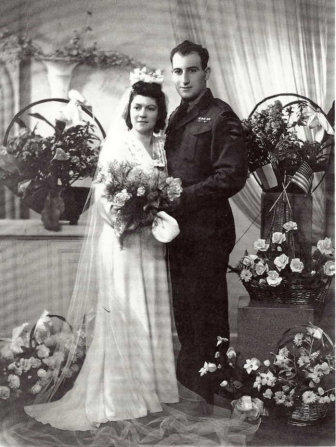
Sources/Additional Information
[1] http://www.cmp-cpm.forces.gc.ca/dhh-dhp/his/ol-lo/vol-tom-3/par2/plf-eng.asp
[2] http://www.48highlanders.com/Downloads/Falcons/7Falcon_Fall2005-F.pdf
[3] https://www.canadiansoldiers.com/history/operations/operationtimberwolf.htm
[4] http://carol_fus.tripod.com/army_hero_timberwolf.html
[5] https://codenames.info/operation/km-iii/
[6] http://www.veterans.gc.ca/eng/remembrance/history/second-world-war/canada-and-the-second-world-war/liri
[7] http://www.veterans.gc.ca/eng/remembrance/history/second-world-war/canada-and-the-second-world-war/rimini
[8] http://www.veterans.gc.ca/eng/remembrance/history/historical-sheets/netherlands
[9] http://www.clareshopper.com/gallery/History/argylewarbrides.html
[10] https://ipfs.io/ipfs/QmXoypizjW3WknFiJnKLwHCnL72vedxjQkDDP1mXWo6uco/wiki/5th_Canadian_Division.html
[11] http://www.cmp-cpm.forces.gc.ca/dhh-dhp/his/ol-lo/vol-tom-3/par2/plf-eng.asp
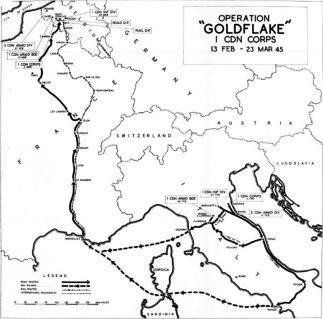
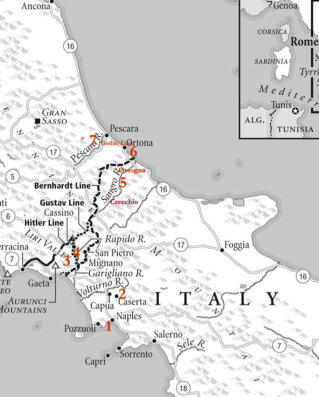
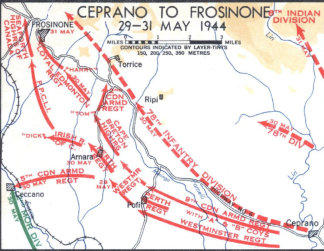
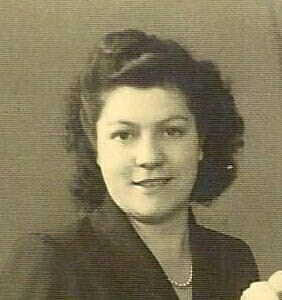
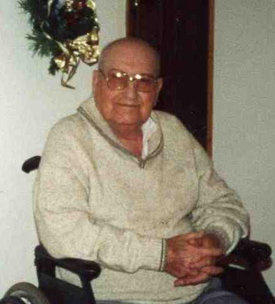
Arthur: Aged 79
Yvonne (DeLetter) LeBlanc
Arthur’s Campaign Medals
(Registration Number 2729;
Issued October 25, 1949)
1939-45 Star
Italy Star
France and Germany Star
Defence Medal
Canadian Volunteer Service Medal and Clasp
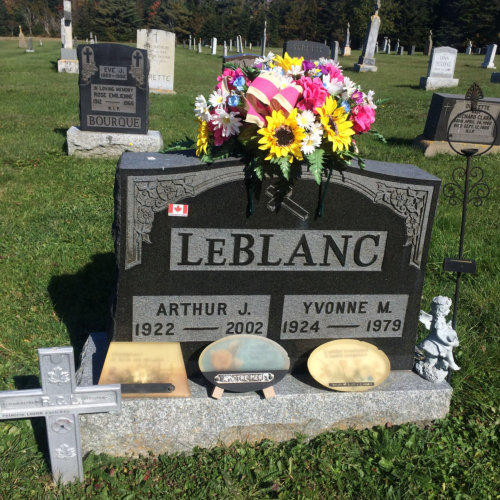
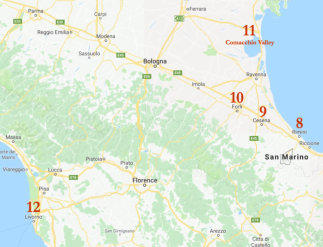
The Princess Louise Fusiliers [11]
BADGE
Description
A grenade Sable issuant therefrom a flame of nineteen points proper charged
with the coronet of a daughter of the Sovereign Or encircled by an annulus
Gules edged, charged in base with two maple leaves and inscribed PRINCESS
LOUISE FUSILIERS in letters Or.
Symbolism
The coronet of H.R.H. The Princess Louise refers to the regiment's name. The
grenade alludes to the original role of fusiliers, who were soldiers specially
equipped to escort artillery trains. The red and white of the flames are the
livery colours of the regiment and the official colours of Canada. "PRINCESS
LOUISE FUSILIERS" is a form of the regimental title, and the maple leaves
represent service to Canada.
MOTTO
FIDELITER (Faithfully)
MARCH
"British Grenadiers"
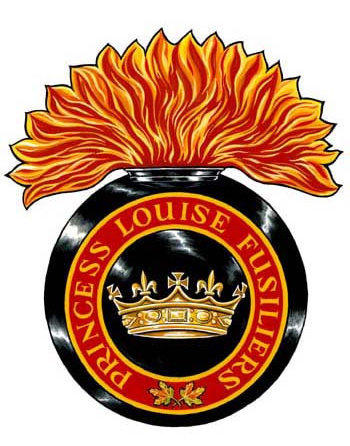


- World War I - Menu
- WWI Stories and Articles
- Photos - Yarmouth Soldiers
- Selection of World War I Songs
- WWI Casualties of Yarmouth, NS
- Those Who Served - Yarmouth, NS
- WWI Casualties Digby Co. NS
- WWI Casualties Shelburne Co. NS
- Merchant Mariners (1915) Yarmouth, NS
- Canadian Forestry Corps - Non Yarmouth Birth/Residence Enlistments
- US Draft Registry - Yarmouth NS Born


- World War II - Menu
- WWII Stories and Articles
- Telegraphist Air Gunners
- WWII Casualties of Nova Scotia
- US Casualties with NS Connection
- Far East/Pacific Casualties with NS Connection
- Merchant Navy Casualties Nova Scotia
- Nova Scotia WWII Casualties Holten Canadian War Cemetery
- D-Day Casualties - Nova Scotia
- CANLOAN Program Casualties - Nova Scotia
- Battle of the Bulge Casualties - Nova Scotia
- WWII Casualties Yarmouth NS
- Yarmouth Casualties - RCAF RAF Canadian Army WWII
- Yarmouth Co., Marrages WWII
- Casualties Non-Born/Residents with Connection to Yarmouth Co., Nova Scotia.
- WWII Casualties Digby Co., NS
- Non-Nova Scotian WWII Casualties Buried in Nova Scotia
- WWII RCAF Casualties Aged 16-18
- Brothers/Sisters Who Served - World War II













